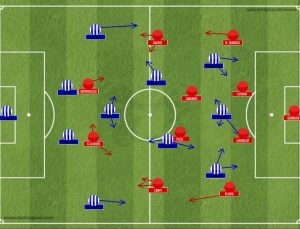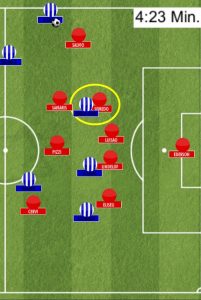Tactical Analysis: Porto 1-1 Benfica
One of the biggest and most competitive derbies in world football, Benfica would make the trip away to Porto’s Estadio Dragao for a mid-season battle. After expectedly strong starts to the season, following excellent transfer windows for both clubs, this early season matchup between two title contenders was highly anticipated. With Nuno’s newly integrated positional play facing the rigid defensive muscle of Rui Vitoria’s 4-4-2, it was sure to be an intriguing clash.
Porto used a pragmatic 4-3-3 shape. Casillas was the goalkeeper, with a back four made up of wing-backs Maxi Pereira and Alex Telles, who flanked central defenders Marcano and Felipe. Danilo played as Porto’s 6, with Otavio and Oliver Torres right and left interiors respectively. Jesus Corona and Diego Jota played inside forward roles, with Andre Silva the central forward.
Benfica compact 4-4-2 was deployed. Ederson Moraes the GK. Right-back Nelson Semedo, Eliseu the left-back, with Lindelof initially being partnered by Luisao at the heart of defence, before an early injury to the Brazilian saw him subbed for Lisandro Lopez. Salvio and Cervi were wide midfielders, whilst Samaris and Pizzi played as central midfielders. Mitroglou and Gonçalo Guedes were the team’s strikers.
Halfspace Control
With Porto basing their attackers primarily in the halfspace, and Benfica attackers making many dropping/inverted movements towards the halfspaces when attacking, it was unsurprising to see this zone of the pitch play an important part in the match.
Impacting far more positively on one team than the other, Benfica’s strategies in controlling the halfspaces both offensively and defensively as well as using them effectively were greater than Porto’s, who encountered issues in this zone and in all phases.
Defensively was were Benfica thrived most in the halfspaces. Though utilising a largely position-orientated defensive system, The Eagles realised the need for adaptation to Porto’s halfspace focus in possession, particularly high up the pitch. Benfica’s wide players adopted a zonal-man approach in defending Porto in the two outer corridors. When Porto’s wingers positioned himself on the last line, or between lines, in the halfspace, he was often in strong positions to combine and make connections from progressive possession into the final third. Due to the potential impact of these players, Benfica placed such intense focus on defending here. Depending on the height of each players, Benfica’s full-back and winger would alternate between who marked the forward and who retained their base position whilst remaining in a position of defensive access on Porto’s attacking full-back.
We can see in the situation above that due to Alex Telles position not being overly advanced on the wing, Salvio is the one to press him, with Nelson Semedo defending from a very narrow position, being the one man-marking Diego Jota in the left halfspace. In the case of the full-back marking Porto’s inside forward, Benfica’s ball-near centre-midfielder would shift slightly towards the halfspace, in order to block any diagonal lane to the inside forward. Due to being in the Benfica’s CMF’s cover shadow, this meant if Porto’s inside forward was to manage to receive a diagonal pass from the wing, he would have very little space to turn, due to being marked, nor dribble backwards.
The opposite was also possible however. In the case of Telles being positioned very high on the wing, and Jota dropping in between the lines to what could be considered a midfield space, Salvio would tuck inside to mark Jota, whilst Semedo, though not marking Telles on the wing, would defend from a slightly wider position than if he was marking Jota.
By adapting their zonal system slightly in order to increase defensive strength in an area their opponents could potentially gain superiority, Benfica were able to maintain control of halfspaces very effectively. Looking at it objectively however, there remained flaws in the system, even if they weren’t exploited hugely by their rivals. One potential issue was the large gap left between Benfica’s full-back and winger should the full-back remain marking inside, whilst the wide midfielder puts pressure on the wing. With such a large gap, there was potential for through balls to vertical or diagonal runs from Porto. These runs were sometimes made the inside forwards, Andre Silva or even Otavio making a late underlapping run from deep. Though not often successful, due to the great pace of all of Benfica’s backline allowing for recovery sprints and tackles, this gap would certainly be a worry for future exploitation should this adaption to the system make a return. A second issue in the system stemmed from higher up the pitch. Despite not pressing high to any sort of degree, Benfica’s strikers putting small amounts of pressure on any deep Porto’s ball-carriers was important in order to prevent simple building and progression. If this first line was breached easily, and allowed access to any of the three central corridors, Benfica’s midfield four faced a central overload with Porto in possession. Pressure had to be put on the ball-carrier, which meant one of the midfielder stepping out to press. Due to situationally having a man less in midfield, Benfica (particularly the WMF’s) couldn’t maintain a focus on blocking passes to the inside forwards in the halfspace, as retaining compactness in the centre still remained priority. Overall however, these issues were small compared to the positives which allowed Benfica great halfspace control defensively.
It wasn’t all positive defensively in the halfspaces however. Despite their opponent’s admirable control of their halfspace in defence, Porto failed to emulate this. The Dragons rather saw chaos in the halfspaces when defending, providing Benfica with numerous opportunities to progress through these zones.
With Otavio and Oliver Torres mainly pressing higher up onto Benfica’s CMF’s, Danilo was left to cover large spaces on his own as a six, particularly horizontally. In order to defend the spaces behind the 8’s in the halfspaces, Porto relied on Danilo to make intense horizontal shifts. With Danilo vacating his central 6 position frequently, this quite often left the centre and ball-far halfspace open for Benfica. With Mitroglou and Guedes being very willing to make dropping movements, these spaces were perfect. Benfica were relatively successful in exploiting these spaces. The movements and patterns from them were certainly correct, with the strikers dropping slightly to receive in the space to either lay-off (Mitroglou) for an onrushing runner, or turn and dribble at the defence (Guedes) if able. The only reason these spaces weren’t exploited more frequently was due to the difficulty of the pass required. A high, diagonal pass with just the correct weight was required for the ball to drop perfectly to the receiver in the far halfspace.
Though not exploited to their full potential in attack, due to the difficulty of the execution required, Benfica’s control and usage of the halfspaces were excellent. Perhaps even more impressive was that their control of these spaces all came as a result of strategies designed to combat their opponent’s movements in both phases.
Central Attacking Focus
Lining up with three forwards who occupied the three central corridors, it was unsurprising to see Porto have a central focus in their attacks.
The frontline of Jesus Corona, Andre Silva and Diego Jota were primarily based in their halfspace and the central corridor. Though there was great variation in their movements from these spaces, it was clear to see the focus and basis of all movements was to create combinations and openings for central breakthroughs. In order to provide some width to a relatively narrow attack, there were diagonal movements from central spaces onto the wing. This was not a total vacation of the centre however, as it appeared that was a basic rule that all central three corridors on the last line must be occupied. When Andre Silva commonly made diagonal movements from the centre to wide in a halfspace, the winger whose position he crossed would swap runs with him, making a run into depth in the centre, ensuring this corridor remained occupied despite its main inhabitant vacating.
Theoretically, these explosive movements had great potential for confusion, dismarking and generating dynamic superiority. The execution was very good, with Porto being successful in their application of the rule of occupying all corridors on the last line. The only problem was that on the right, where these movements where more commonly made by A.Silva and Corona, Lindelof was able to use use his excellent pace to recover and kill the dynamic superiority frequently.
Another superiority Porto look to generate with their occupation of the central corridors on the last line was numerical. By overloading the centre backs (3v2), Benfica were sometimes forced to adjust and drop closer, or even into the backline. By doing so, this caused unbalances elsewhere, which Porto would look to exploit. This was mostly done through combinations, which Andre Silva would usually be at the centre of. Despite Benfica adjusting to protect their backline, A.Silva would still be able to emerge from behind a defender for a second to be used as a wall player in the combination. This was done to draw pressure towards the last line, opening up space elsewhere, which Porto would look to access following local combinations to escape pressure.
The end product of the combination would be for a midfielder/ball-far full-back to receive in an area of little Benfica defensive presence, in front of their backline. Despite Benfica being position-orientated, they were often drawn towards the ball and areas of opposition overloads, making Porto very successful in this overload, unbalance, exploit pattern.
Though Porto’s overloading and often complex attacking movements were largely successful in manipulating the Benfica defensive structure, it wasn’t all perfect. Similarly to many other attacking structures which rely heavily on overloads, particularly centrally, Porto frequently experienced congestion in the centre and halfspaces in the final third. At times, there was an over emphasis on getting numbers onto the last line, which saw the structure suffer, making connections and circulation through central-midfielder especially difficult or unclean. Due to forcing Benfica to adjust and place more emphasis on defending around their backline, Porto also found this area more difficult to connect with cleanly and consistently, due to increased defensive presence. With a lot of defenders local to this area, there were many cover shadows or players with defensive access. When receiving on the last line, Porto were then often left relying on dribbles in tight spaces to progress and create in the final third. Expectedly, due to skillsets, this was far more effective with Diego Jota on the left.
Conclusion
As expected, an affair between two sides with different tactical strategies was a terrific clash. Though the systems in each phase for both teams were largely contrasting, the speed and purpose in attack and intensity, whether through high or deeper pressure in defence, were extremely similar in a high-octane affair.
Most likely deservedly ending as a 1-1 draw, neither manager can really complain with just a point when analysing both team’s strong performances.
Writer: Ross Eaton/@boxtoboxcb
Picture: sapo.pt



